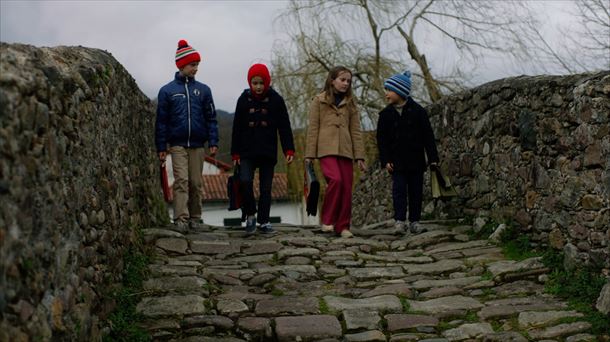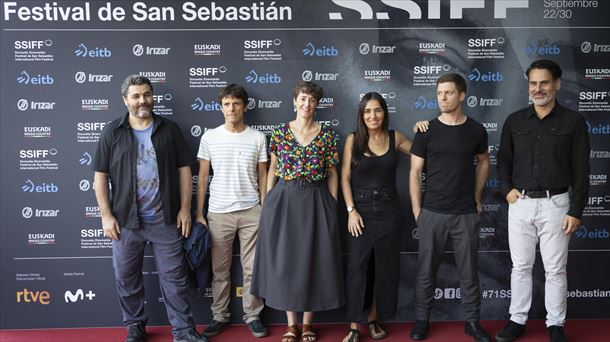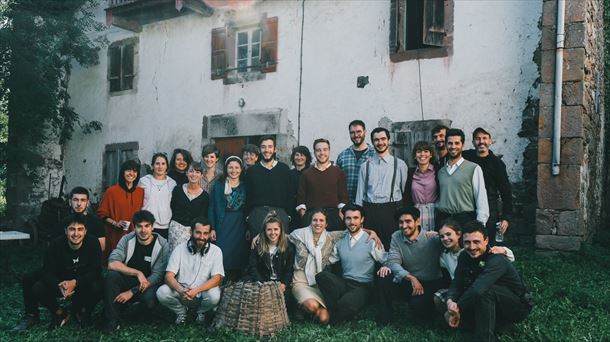Josu Martinez: “I wanted to tell about the 20th century of Basque speakers”
Euskaraz irakurri: Josu Martinez: “Euskara jendearen XX. mendea kontatu nahi izan dut”
Joshua Martinez and the Zinemaldia in San Sebastián will prolong their lasting idyll this year. Martinez presented his work for the first time at the Festival in 2009 (Itsasoaren praises), and since then several more works by the filmmaker and film researcher born in Bilbao in 1986 have been selected.
This year, Josu Martinez will present two works in the Zinemira section of Zinemaldia, dedicated to Basque cinema, and both films will be eligible for the Irizar award. One of them is Bizkarsoro, a collective feature film that compiles five global stories collected in Baigorri and brought to the screen by its inhabitants. Through these narratives, a story is articulated that describes the process between 1914 and 1982 by which the majority language of some small Basque towns changed from Basque to Spanish.
In addition, Zinemaldia has also selected for its programming Mirande. Film bat egiteko zirriborroa. This work by Josu Martinez delves into the figure and literary production of the writer Jon Mirande through his own words (he is played by the actor Peio Berterretxe) and testimonies from experts (Joseba Sarrionandia, Itxaro Borda, Amaia Elizalde…) and family members. , without avoiding, for example, his phil-Nazi attitudes.
We have spoken with Martinez.
You arrive at Zinemaldia with two films under your arm. What has the creation process of both works been like?
The development of both works has been very different. Bizkarsoro It is a popular project, especially in its content but also in its form. We have been creating it in parts since 2018, at the rate of one chapter a year.
In the case of Mirande, we had the film finished a long time ago. At first, I wanted to release it at the end of last year, since it was 50 years since Mirande’s body was found in her Paris apartment. But some members of the Zinemaldia management saw the film, they liked it a lot and told us that they were interested. So we thought it was a good option to wait and release it now.
You have a long and close relationship with Zinemaldia. What function does Zinemaldia play within cinematography and the Basque film industry?
Yes, you’re right, I was there for the first time in 2009, with the documentary Itsasoaren praises, and since then, if I’m not mistaken, I have presented ten films there. The truth is that I am not a big festival fan, I don’t usually go to parties and the like, but there is no doubt that presenting a work here gives the film great visibility; This is a great opportunity for those who, like me, make small films.
In that sense, it is tremendous luck to have a great festival like this in Euskal Herria, which is sensitive to local creators.
In any case, I think there is a kind of trap in that fortune. I mean that for a week it seems that everyone is a film lover and that everyone wants to see movies, but then, throughout the year, that disappears completely, not to mention in the case of works done in Basque. .
As with Durangoko Azoka, it appears to be an annual dose. May God free us from falsehood.
How do you experience Zinemaldia, whether you participate in it with a film or not, and how would you like to experience this year’s event?
I will go to the presentations of my films, nothing more. Beyond that, I already have enough work as a father and as a professor at the UPV.
In any case, I want to experience the moment of the premiere with the people. For BizkarsoroFor example, a lot of people from Baigorri will come, including bagpipers… It will be beautiful to share that moment with the citizens.

‘Bizkarsoro’
Precisely in Bizkarsoro, you take five photographs of the 20th century, to show how at that time French was taking the place of Basque in the mouths of the inhabitants of some Basque towns. Why those five specific moments?
Just as Bertolucci counts on Novecento the history of the labor movement in the 20th century, I wanted to tell the history of Basque speakers; not the history of Basque, but that of Basque speakers: how a language dies.
We still hear a lot that Basque is inevitably dying in Euskal Herria, as if it were the natural death of a grandmother. And I want to show that no, that of the Basque language is in any case (he is still alive!) a programmed and planned death.
At the beginning of the 20th century, in many small Basque towns, French and Spanish were not the majority, while by the end of the century the situation was diametrically opposite. What happened in that interval? Two wars, compulsory schooling, class struggle, social pressure… That is, the construction of a nation (the construction of the French nation).

The “Bizkarsoro” team at the Basque Cinema Gala
Bizkarsoro look back as a memory exercise. What function does cinema have as a repository of popular memory? Do you understand cinema beyond its function to explain the world?
Don’t know. I like movies that help me think. I don’t dare say more than that.
If cinema helps change the world? I don’t think so. It seems to me that the world can be changed with the screens off, in any case.
Cinema is an expensive and sometimes quite vertical method of expression, but Bizkarsoro It is “collected from the mouths of the people and told from their eyes.” How has the collaboration and relationship been with the inhabitants of Baigorri?
Imagine it: Baigorri has about 1,000 inhabitants, and about 200 of them have participated in the film, either in front of or behind the camera. From the beginning it has been a popular project, carried out jointly and closely linked to creating community.
On the one hand, the entire team has been Basque, we have worked entirely in Basque behind the cameras, and we have tried to bring together leading professionals from Hegoalde with the inhabitants of Iparralde who are taking their first steps in cinema, since They were amateurs or simple fans.

Filming of ‘Bizkarsoro’
In this way, the team from Hegoalde has trained those from Iparralde, and we have taken a step forward to start making films in Iparralde. Let’s take as an example the art director Izaskun Urkijo, who has been working with the same collaborators for several years and has trained those people. She has taught them the trade. I think all of that is very nice.
On the other hand, we have always moved very close to reality. If you like, Bizkarsoro It is a film that also has something of a documentary. I have collected everything that is told from direct testimonies, and almost all of the interpreters are from the town, not professionals who have represented themselves, or their grandfathers, grandmothers, mothers and fathers, as is the case of the boys and girls of the Baigorri ikastola.
I think all of that has made a great impression on them, and some people have been very impressed by participating in the film. I would say that all that authenticity comes through on the screen.
On the other hand, Mirande. Film bat egiteko zirroborroa looks at the controversial figure of Jon Mirande, to whom he gives voice through his writings. Why did you want him to speak directly?
Mirande has interested me for a long time. I have always found him to be a formidable writer, but I would say that, above that, he has always highlighted what other people have said about him: accusations, convictions, etc. If he was a Nazi, a pedophile, I don’t know what else…
So, I thought it might be interesting to give voice to Mirande himself, to listen to Mirande.
Peio Berterretxe plays Mirande on camera. How have you prepared the role, taking into account that there is very little audiovisual material about Mirande?
Peio Berterretxe is a very cutting-edge actor, who has completed higher education in Paris and has been part of the Comedie Française company.
Two or three years ago he returned to Euskal Herria, and, from the moment I saw him, I thought he would be the right person to play Mirande. Later I had other ideas like looking for someone more similar to Mirande, looking for an anonymous actor…
Ultimately, Peio is not Mirande, we did not want to create a classic fiction, we did not play with verisimilitude. We have created a film device, a kind of Brechtian artifact to be able to listen to Mirande’s words and through them, in some way, to Mirande.
How do you recommend reading Mirande? Where to start?
There are many Mirandes. And his work, despite being brief, is very rich.
Mirande was a great poet, a magnificent writer of stories, and also a thinker (with his debatable thoughts). Everyone will find their Mirande.
What I would say is that perhaps it is interesting for us to learn to enjoy Mirande (and, in general, literature, cinema, art) without necessarily having to agree with the text.
Source: Eitb
Bruce is a talented author and journalist with a passion for entertainment . He currently works as a writer at the 247 News Agency, where he has established himself as a respected voice in the industry.












